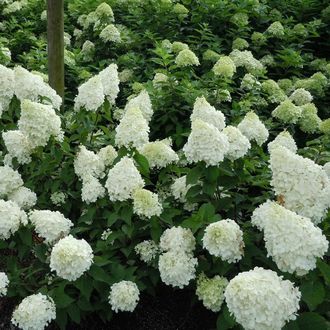Content
- 1 Description of the most popular varieties for the Moscow region and central Russia
- 2 The best large-fruited gooseberry varieties
- 3 The best winter-hardy gooseberry varieties
- 4 The best studless gooseberry varieties
- 5 White Nights
- 6 Candy
- 7 Pink 2
- 8 Seedling Lefort
- 9 Cooperator
- 10 Belarusian sugar
- 11 Russian yellow
- 12 Sirius
- 13 Beryl
- 14 Chernomor
- 15 How to choose a gooseberry variety
- 16 Review of the best gooseberry varieties
- 17 Recommended varieties for the Moscow region
- 18 Varieties for central Russia
- 19 ★ Top 7 sweetest and most delicious gooseberry varieties
- 20 🎥 Video advice from Pomoleiko Alexander Vladimirovich "Gooseberry varieties are red, green and thornless"
- 21 Gooseberry varieties for wine
- 22 Heading "Question-answer"
Gooseberries can be found in almost every site in the central region of Russia. Gardeners often think about which variety to choose and plant. Let's try to figure it out together by reading the description of the most popular ones. Varieties are divided according to many criteria, Kolobok, Grushenka, Russian yellow and Amber are most suitable for the Moscow region... The most frost-resistant are Beryl, Ural emerald, Consul and others. The largest fruits are produced by the varieties Zashchitnik, Kooperator, Leningradets and others. They have excellent taste - Medovy, Kaptivator, Pushkin, Sadko, Laskovy, English, Mashenka and others. Thornless gooseberries are the safest, besides, it is easier to care for them, the best and most popular varieties are Eaglet, African, Thornless gooseberry and others.
Description of the most popular varieties for the Moscow region and central Russia
Grushenka
 Gooseberry variety Grushenka
Gooseberry variety Grushenka
Medium-sized shrub with drooping branches. There are practically no thorns on the shoots. The berries are medium-sized, weigh on average 5 grams, the shape is pear-shaped, and the color changes as the fruits ripen (from pale red to deep purple). The variety is perfect for growing in central Russia, it is able to easily endure frosts, winter cold and drought. It is immune to many diseases.
Russian yellow
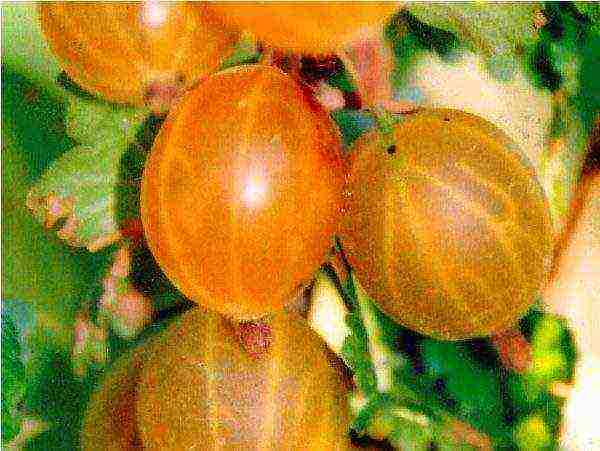 Gooseberry variety Russian yellow
Gooseberry variety Russian yellow
A low bush with medium spreading, covered with thorns throughout the area. Produces yellow pear-shaped fruits weighing up to 6 grams... The presence of a thin waxy coating is characteristic. The variety is distinguished by its excellent tolerance to sudden changes in temperature, frost and drought. Self-fertile, not affected by many common diseases.
Amber
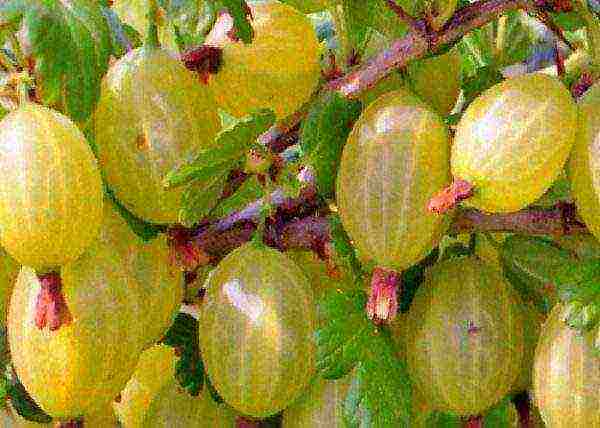 Gooseberry grade Amber
Gooseberry grade Amber
A tall shrub can grow up to 1.5 meters. The crown is dense and spreading, and there are also many thorny thorns on it. But all these disadvantages are offset by delicious and beautiful fruits. Berries are yellow-orange in color and oblong in shape, on average, weigh 5-6 grams... Amber gooseberries are early varieties and have a very high yield. Also, this shrub tolerates frost and drought well.
Gingerbread man
 Gooseberry variety Kolobok
Gooseberry variety Kolobok
A medium-sized shrub with thorns, which are located singly, most often on the lower part of the branches. Fruits are large in size, their weight reaches 7 grams... The shape of the berries is slightly elongated, the color is pale red. The taste is pleasant, sweet and sour. The variety tolerates frost well, is resistant to anthracnose and powdery mildew.
The best large-fruited gooseberry varieties
Defender
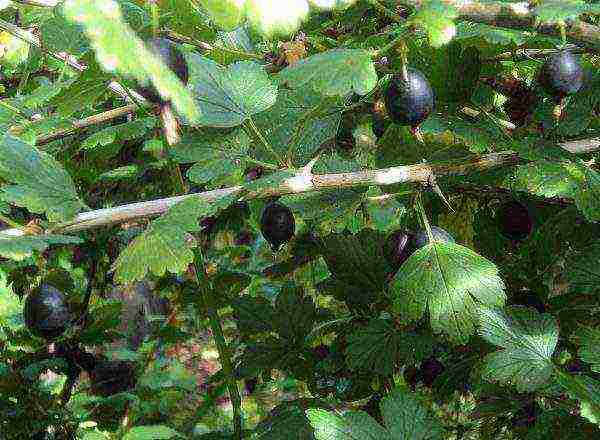 Gooseberry variety Defender
Gooseberry variety Defender
A tall shrub with powerful branches and a straight crown. The mass of berries can reach 10 grams, their shape is oval-pear-shaped, the color is burgundy, almost black... The taste of the fruit is sweet and sour. Refers to varieties with a late ripening.The defender tolerates frost well, does not undergo powdery mildew.
Cooperator
 Gooseberry variety Cooperator
Gooseberry variety Cooperator
This type of shrub has a medium height and a sparse, slightly spreading crown with a small number of thorns. On average, one berry weighs 7 grams, pear-shaped, dark red color... Such fruits are considered dessert, they are very tasty and sweet. Up to 5 kilograms of harvest can be harvested from one bush, the ripening period is medium late. Another advantage of the variety is its resistance to cold weather and fruit rot.
Leningrader
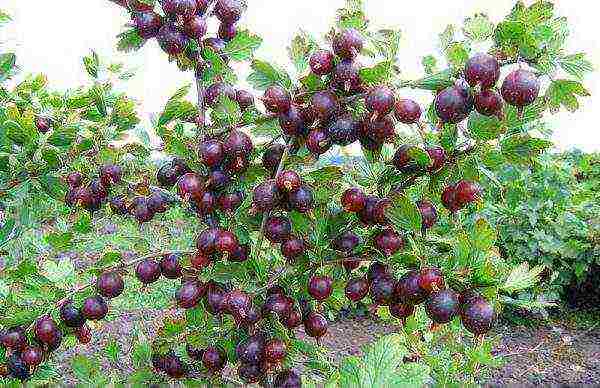 Gooseberry grade Leningradets
Gooseberry grade Leningradets
A bush of medium height with a semi-spreading crown, thorns are practically absent. The berries are large in size, their weight can reach 10 grams, the shape resembles an inverted egg, the color is dark red... Gooseberry taste sweet and sour. From one bush, you can collect up to 7.5 kilograms of harvest, medium late ripening. The shrub is winter-hardy, moderately exposed to powdery mildew.
Spring
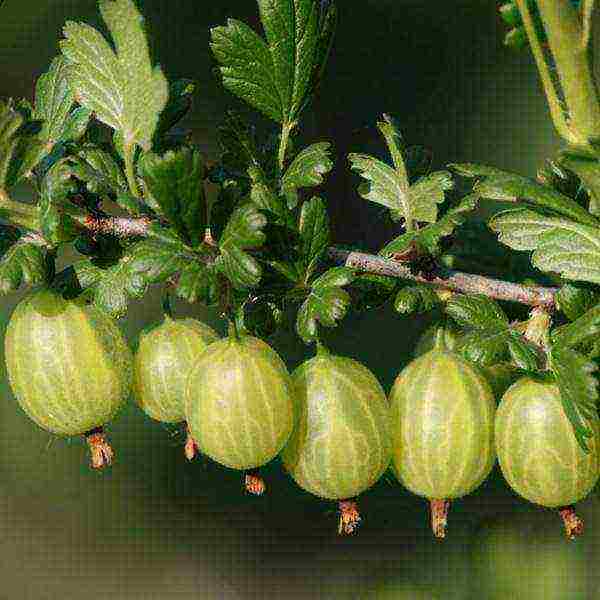 Gooseberry variety Rodnik
Gooseberry variety Rodnik
Shrub of medium height with a compact, neat crown. On average, the fruits weigh 5-6 grams, but their weight can reach 8 grams, the shape is round-oval, the color is dull, yellow-green... The taste of such berries is very pleasant, sweet, they are suitable both for fresh consumption and for any kind of processing. The variety is resistant to frost and fungal diseases, it is distinguished by its ability to reproduce crops even under unfavorable climatic conditions.
The best winter-hardy gooseberry varieties
Beryl
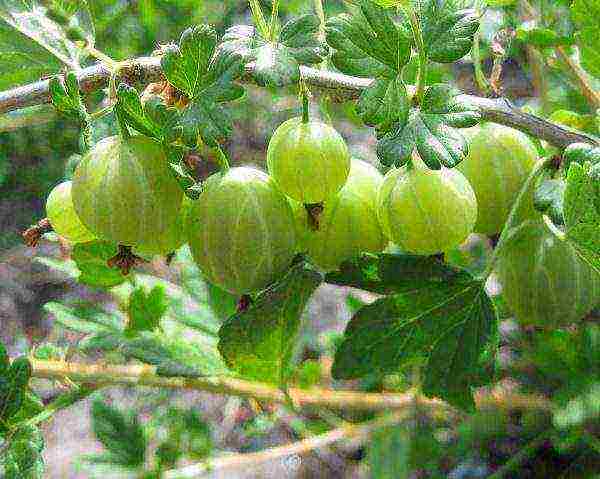 Gooseberry Beryl grade
Gooseberry Beryl grade
Medium-sized shrub with a neat crown. Thorns are present at the bottom of the shoot. The weight of the berries can reach 8-9 grams, the shape is spherical, the color is light green... The taste of the fruit is dessert, highly appreciated by professional tasters. One bush brings up to 9 kilograms of harvest and can survive frost down to -36 degrees. Also, the variety is resistant to fruit rot.
Ural emerald
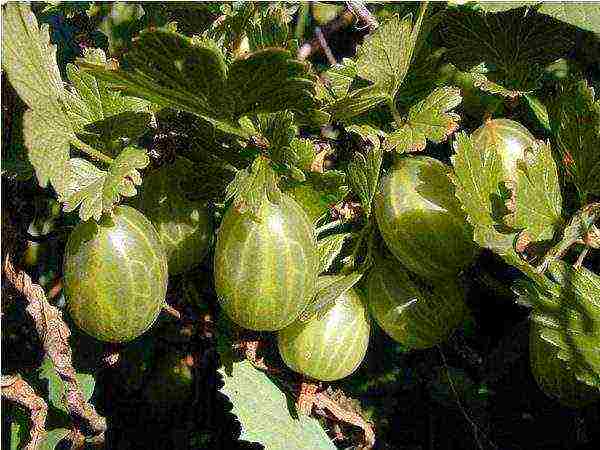 Gooseberry grade Ural emerald
Gooseberry grade Ural emerald
Medium-sized shrub with few thorns on the shoots. Berries are distinguished by the absence of pubescence, their weight can reach 8 grams... This variety got its name due to the bright color of the fruit with a dessert taste and pleasant aroma. The first harvest can be obtained at 3-4 years of life, the ripening period is medium early. Frost resistance is high, such a shrub can withstand cold temperatures down to -37 degrees.
Consul
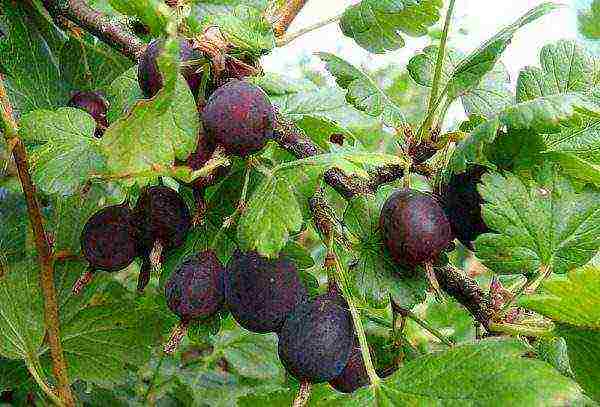 Gooseberry grade Consul
Gooseberry grade Consul
Another name for this variety is senator. A medium-sized bush with a dense crown, on which there are practically no thorns. The berries are large, their weight can reach 6 grams, the color is maroon, almost black... The skin of the fruit is very thin, so they do not tolerate transportation well. Also, such berries have very few seeds, which makes them an excellent jam. The shrub tolerates frosts well down to -37 degrees. In the first years of his life, the Senator gives little harvest, but over time this figure increases 2-3 times.
Belorussian
 Gooseberry grade Belarusian
Gooseberry grade Belarusian
A small bush with a compact crown, on which there are a lot of sharp thorns. Ball-shaped berries weigh no more than 8 grams... The color is bright green. The taste is very pleasant, sweet, the skin of the fruit is thin, and the pulp is juicy and tender. The variety belongs to the old selection, has a very high frost resistance (up to -39 degrees). The harvest ripens in medium terms.
Krasnoslavyansky
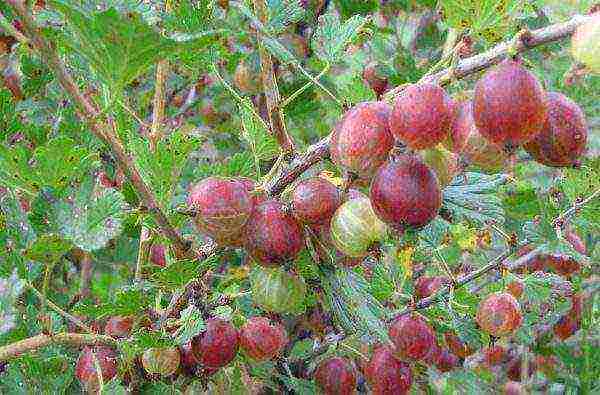 Gooseberry grade Krasnoslavyansky
Gooseberry grade Krasnoslavyansky
The bush is of medium height, slightly spreading, the crown is sparse, there are thorns on the shoots. The berries are large enough, the maximum weight can reach 9 grams, the shape is round, the color is deep red... There is practically no pubescence on the skin. The taste of such gooseberries is considered dessert. The first crop can be harvested already in the second year of the plant's life, but over time this figure becomes larger and reaches 6-7 kilograms. Also, the variety is very frost-resistant, resistant to powdery mildew.
The best studless gooseberry varieties
Eaglet
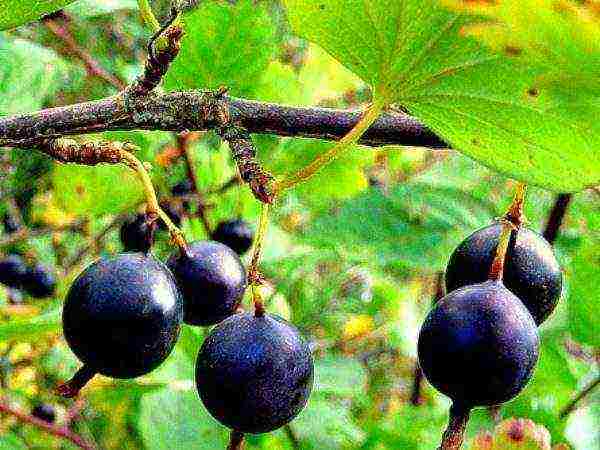 Gooseberry grade Eaglet
Gooseberry grade Eaglet
A medium-sized shrub with a neat and small crown. The lack of thorns makes this variety one of the most popular among gardeners. On average, one berry weighs 4-6 grams, the color is almost black... Differs in the presence of a light military raid and a pleasant sweet and sour taste. The crop ripens early, the shrub bears fruit annually and abundantly, resistant to frost and fruit rot.
African
 Gooseberry variety African
Gooseberry variety African
A medium-sized bush with no thorns. The berries are not large, rounded, dark purple in color... The taste of the fruit is sweet and sour, with light notes of black currant. The shrub begins to bear fruit in 2-3 years after planting, has good winter hardiness and resistance to many diseases. There is a risk of contracting anthracnose.
Northern captain
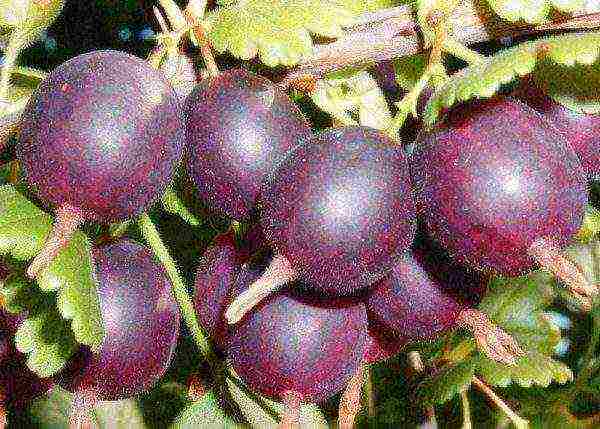 Gooseberry variety Northern Captain
Gooseberry variety Northern Captain
One of the most popular gooseberry varieties. A tall shrub with a narrow, neat crown, the branches of which grow straight up. Berries are dark, almost black in color, their weight can reach 4 grams... The taste of the fruit is pleasant, with a slight sourness. The ripening period of the crop is average. With proper care, up to 12 kilograms of fruit can be removed from one shrub... Among other things, the North Captain tolerates frost, drought well and is not exposed to many diseases.
Ural besshorny
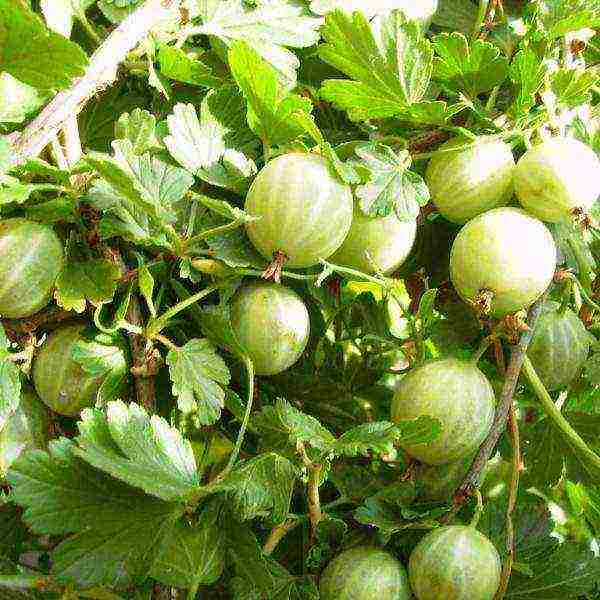 Gooseberry grade Ural Besshipny
Gooseberry grade Ural Besshipny
Medium-sized shrub that bears bright green, large (up to 8 grams) oval fruits... The variety is medium late, there is no pubescence on the skin, the fruit pulp is sweet and pleasant to the taste. The variety tolerates frost well, but may begin to drop berries ahead of time, which will lead to a loss of yield. Gooseberries are recommended to be picked a little earlier than they are fully ripe. In addition, the absence of thorns will make this process even easier and more enjoyable.
Thornless gooseberry
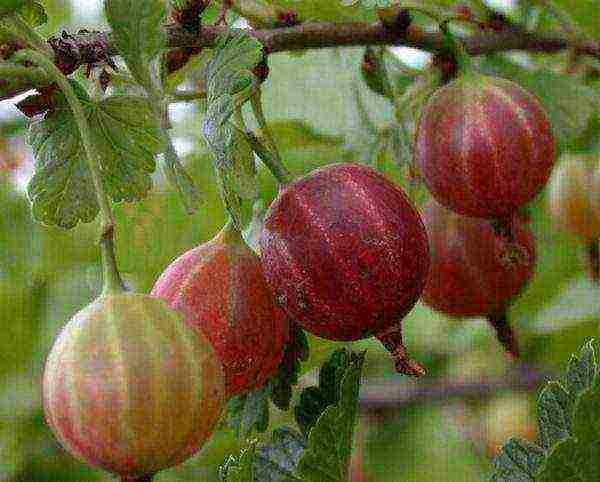 Thornless gooseberry
Thornless gooseberry
The bush is vigorous, but at the same time its crown is very compact, and the branches grow mainly upward. On average, the berries weigh 5 grams each, have a drop-like shape and a light red color.... The taste of the fruit is pleasant, sweet with a barely noticeable sourness. The variety tolerates winter cold well and is not subject to powdery mildew.
Both adults and children love gooseberries. A resident of any region will be able to choose a variety that is suitable for himself, you can also pick berries according to taste, size and other indicators... The modern market offers a huge variety of different varieties of gooseberries.
Gooseberry, this thorny shrub is at least in one copy, but it must be found on every garden plot. This culture has a rich history and has been known to man for a very long time. Gooseberry was once grown on a large scale in our country, but most of its plantings were destroyed by powdery mildew brought from another continent. It took years for breeders to be able to develop varieties that are resistant to this ailment, and now the demand for gooseberry planting material and the area under this crop is increasing every year.
Various varieties of gooseberries
At the moment, there are 46 varieties of this wonderful crop in the State Register of Breeding Achievements of the Russian Federation, the very first varieties of gooseberries were obtained back in 1959, these are the varieties: Malachite, Russian, Seianets Lefora, Smena and Chelyabinsk green. New items introduced in the 21st century: White Nights, Defender, Kazachok, Candy, Favorite, Narodny, Spring, Northern Captain, Serenade, Snezhana, Ural Emerald, Ural Pink, Flamingo, Shershnevsky and Eridan.
Each of these gooseberry varieties is recommended for one or several regions of the Russian Federation, selected in accordance with a number of climatic features. There are 12 such regions in total, one or another gooseberry variety is recommended for each of them. Let's take a closer look at the varieties and find out for which of the regions this or that cultivar is recommended.
Let's start with the variety Harlequin, it was received in 1995 and recommended for regions 9 and 10 - Ural and West Siberian... This gooseberry variety is characterized as late, it is a shrub, it is characterized by an average vigor of growth, an average spreading crown and has rather large leaf blades of green color. There are usually three flowers in the inflorescence of this variety. After flowering, the berries are tied, they are red in color, round in shape, with a taste estimated by tasters at 4.4 points out of 5 possible. Fruits contain up to 6.0% sugars, more than 3% acids, over 24 mg% ascorbic acid. The yield per bush reaches 2.5 kg. The variety is not affected by powdery mildew, rarely damaged by the sawfly.
Cultivar White Nights was launched in 2000 and recommended for cultivation in the second, Northwest region... The fruits of the variety ripen early. The plant itself is a very modest bush with straight, thorny shoots. The leaf blades are medium in size and green in color. In the inflorescence there is usually one, less often - two flowers. Gooseberry fruits weighing about 3.5 g, their shape is round, yellow-green in color, there is a slight pubescence. Tasters rate the taste at 4.3 points, the appearance at 4.4 points. Each berry contains up to 10.9% sugars, over 1.8% acids, up to 30 mg% ascorbic acid. The maximum yield per bush is 3.1 kg. The variety is resistant to powdery mildew.
Gooseberry variety Beryl was included in the State Register in 1998 and recommended for growing in regions 9 and 10 - Ural and West Siberian... It is a medium-sized shrub with a slightly spreading crown. Shoots are usually curved, have spines only on the bottom. The leaf blades are rather large. There are two flowers in the inflorescence. The fruits are round, weighing about 3.5 g, yellow-green in color with a skin devoid of pubescence. Tasters rate the taste of berries at 4.4 points, the attractiveness of the appearance - at 4.5 points. Each berry of this variety contains up to 9.8% sugars, about 0.5% acids, more than 38 mg% ascorbic acid. The maximum yield per bush is about six kilograms. The variety is resistant to powdery mildew and has a high winter hardiness.
Gooseberry cultivar Harlequin Gooseberry cultivar White nights Gooseberry cultivar Beryl
Vladil, - this gooseberry variety was obtained in 1995 and recommended for cultivation in 2, 4, 7, 9 and 10 regions, these are the North-West, Volgo-Vyatka, Middle Volga, Ural and West Siberian regions... The harvest of this variety ripens early. Plants of the variety are actively growing shrubs with a slightly spreading crown. The leaf blades are rather large, dark green in color with shine. There may be two or three flowers in the inflorescence. The fruits of the variety reach a mass of 2.9 g, they are red, quite tasty, tasters estimate this indicator at 4.3 points, and the appearance - at 4.4 points. Berries contain up to 15% sugars, more than 2.8% acids, over 28 mg% ascorbic acid. The maximum yield of the variety is about two kilograms per bush. The cultivar is immune to powdery mildew, but can be damaged by the sawfly.
Defender, - this gooseberry variety was obtained relatively recently, in 2010 and recommended for cultivation in the third, Central, region... The variety is characterized by late ripening. Plants of this variety are actively growing shrubs with straight shoots, completely covered with thorns, and large leaf blades of a dark green color. Each inflorescence can have from one to three flowers. The fruits of this species are oval-pear-shaped, dark red, almost black, in color and a noticeable waxy coating. The average weight of the fruit is about 4.9 g. The taste of the berries is quite pleasant, it is rated by tasters at 4.5 points, and the appearance - at 4.6 points. The maximum yield per bush reaches 5.6 kilograms. The variety is drought-resistant, winter-hardy, but can be affected by powdery mildew.
Kazachok, - this gooseberry variety was included in the State Register in 2006 and recommended for growing in the fifth region - Central Black Earth... The ripening period for the variety is medium late. Plants of the variety are shrubs with medium vigor and a spreading crown due to their curved shoots. The leaf blades are bright green in color. In an inflorescence there can be either one or two flowers. The fruits of the variety have a mass of about 3.6 g, they are oval, dark red in color, slightly pubescent. The taste of the berries is quite pleasant, tasters rate it at 4.9 points, which is a very high rating. Each berry of the Kazachok variety contains up to 11.7% sugars, about 1.4% acids, up to 39.8 mg% ascorbic acid. The maximum yield per plant reaches eight kilograms. The variety is resistant to powdery mildew.
Gooseberry variety Vladil
Gingerbread man, - this gooseberry variety was obtained in 1988, it recommended for growing in 3, 4, 5 and 11 regions, that is, in the Central, Volgo-Vyatka, Central Black Earth and East Siberian... The variety is characterized by an average ripening period and high yield, reaching six kilograms per bush. The plant of the variety is a medium-sized bush with a rather dense and spreading crown. The thorns on the shoots are small, there are few of them. In inflorescences there can be either one or two flowers. The fruits are very large, can reach a mass of 8.1 g, they are round, dark red. Taste qualities are estimated at 4.6 points. The variety is resistant to powdery mildew.
Candy, - this cultivar was included in the State Register in 2008 and recommended for cultivation in 10 and 11 regions - West Siberian and East Siberian... The variety is characterized by an average ripening period. Plants of the variety are medium-sized shrubs with a compact crown and rather thin shoots. Thorns, like shoots, are thin, located singly and usually only in the lower part of the shoot. In an inflorescence there can be either one or two flowers. The fruits are medium-sized, spherical, red in color. The taste of the gooseberry is quite pleasant, rated 4.7 points by the tasters. The average weight of the fruit is about 3.2 g. Each berry contains up to 8.7% of sugars, more than 1.1% of acids, and more than 55.1 mg of ascorbic acid. The maximum yield of the variety reaches 2.4 kg per bush. The variety is resistant to drought, not afraid of frost.
Cooperator, - gooseberry variety obtained in 1999 and recommended for two regions - 9 and 11, these are the Ural and East Siberian... The crop ripens in the middle late terms. The maximum yield often exceeds six kilograms per bush. Plants of the variety are shrubs of medium height, with a compact, moderately spreading crown. Shoots have thorns only in the lower part, which makes harvesting somewhat easier. There can be two or three flowers in the inflorescence. Fully ripe gooseberry fruits reach a mass of 7.6 g, are pear-shaped and dark red in color, sometimes they look black. The taste is very pleasant, it is considered dessert, its tasters estimate it at 4.9 points. The variety is resistant to powdery mildew.
Gooseberry variety KolobokGooseberry variety CandyGooseberry variety Cooperator
Krasnoslavyansky, - this gooseberry variety was included in the State Register in 1992 and recommended for three regions at once - 2, 3 and 4, these are North-West, Central and Volgo-Vyatka... The harvest of this variety ripens in medium terms, the yield is quite high, reaching seven kilograms per bush. Plants of the variety are small shrubs with a slightly spreading crown. The thorns are small and there are not many of them. The fruits are very large, up to nine grams, their shape is round, the color is dark red, there is a noticeable slight pubescence on the surface. The pulp of the berries is very tasty, tasters rated the taste at 4.5 points. The variety is resistant to powdery mildew.
Red large, - it was received in 1974 and recommended for cultivation in the tenth region - West Siberian... Interestingly, this gooseberry variety was obtained from a seedling that accidentally grew, its parents are unknown.The variety is characterized by medium ripening, high winter hardiness and resistance to a complex of diseases and pests. Productivity ranges from three to four kilograms of fruit from a bush over the years. The plants themselves are of medium vigor and rather spreading. There are thorns in abundance on old shoots, on young ones there are very few of them. The berries are not large, reaching a mass of 3.1 g. The shape of the fruit is elongated-oval, the color is dark red. The taste is quite pleasant, it is rated by tasters at 4.5 points.
Kubanets, - this gooseberry variety was bred in 1997 and zoned in only one region - 6, North Caucasian... The harvest on low and slightly spreading bushes of this variety ripens early. It is easy to collect because the thorns on the thick and straight shoots are located only in the lower part. Ripe berries have an oval shape, green color, do not have pubescence and reach a mass of 5.7 g. The maximum yield from a gooseberry bush reaches 9.4 kilograms on good soil. The fruits of the variety are delicious, tasters rate the taste at 4.5 points, and the appearance at 4.6 points. Each berry contains up to 7.7% sugars, about 2.2% acids, over 33 mg% ascorbic acid. The variety is resistant to powdery mildew and does not require pollinating varieties on the site.
Gooseberry cultivar Krasnoslavyansky Gooseberry cultivar Red large Gooseberry cultivar Kubanets
Cultivar Beloved, - it was included in the State Register at the very beginning of the current century - in 2000 and recommended for growing in the 10th region, West Siberian... Berries on the spreading bushes of this gooseberry variety ripen quite early, it is not very convenient to collect them: very thick shoots are covered with no less thick thorns. However, the berries are worth the trouble of picking, they have an oval shape, weigh about 4.0 g, a yellow-green color of dense skin covered with a waxy coating and a rather pleasant taste, albeit without aroma, rated by tasters at 4.9 points. Each fruit contains up to 8.8% sugars, about 2.0% acids, more than 43 mg% ascorbic acid. The yield of the variety is very high and on good soil reaches 8.7 kg per bush. The advantages of the variety include its winter hardiness, resistance to powdery mildew and relative resistance to the sawfly.
Malachite, - an old gooseberry variety, 1959, but it is he who is most often found in summer cottages. The variety is zoned in many regions, it is easier to say in which cultivation is not desirable, these are regions 6, 10 and 11, namely the North Caucasian, West Siberian and East Siberian... The harvest on vigorous and slightly spreading bushes ripens in medium terms. The maximum yield is about four kilograms per bush. The harvest will have to be done with care, because small thorns are scattered over the entire surface of the shoots. However, no one leaves Malachite berries on the shoots, they say that the most delicious jam comes from the fruits of this variety. By the way, the fruits cannot be called small, they reach a mass of 7.1 g, have a slightly elongated shape and a rich green color. The taste is pleasant, the tasters are rated at 4.6 points. The variety is resistant to powdery mildew.
Lighthouse, - this gooseberry variety is newer, it is included in the State Register in 1992 and zoned only in one region - in the North-West (2)... Harvest on well-developed bushes with arched shoots ripens in medium terms. Harvesting is not very easy: the shoots have very sharp thorns, which are sometimes very densely distributed. The mass of berries is not a record - about 3.3 g, the yield is also at an average level - about 5.2 kg per bush. Why is the variety good? Pleasant dark red color of berries, good taste, estimated by tasters at 4.3 points, and high sugar content in them - more than 10.5%. In addition, the variety is characterized by high winter hardiness and resistance to powdery mildew.
Gooseberry variety Lyubimets Gooseberry variety Malachite Gooseberry variety Lighthouse
Gooseberry variety Reliable - included in the State Register in 1994 and recommended for cultivation in three regions at once - West Siberian (10), East Siberian (11) and Far East (12)... The harvest on these winter-hardy bushes with a very compact crown ripens in medium terms. With a fruit weight of 3.1 grams, up to 6.3 kg of fruit can be harvested from a bush. Each berry has an oval shape, pink color and a rather pleasant pulp, although due to the perceived acidity, tasters give the taste only 4.1 points. The fruits contain a lot of sugars, more than 11.8%. The variety is resistant to powdery mildew.
A relatively new variety of gooseberries - People's, it was received in 2009 and zoned in the West Siberian region (10)... The harvest on vigorous bushes of this variety ripens late, which allows to extend the period of consumption of fresh berries. It is quite convenient to pick berries, because there are thorns only at the bottom of the shoots. The mass of the berries is average - about 3.3 points, they are round and dark red in shape. The taste is very pleasant, judged by the tasters at 4.9 points, but the yield is not very high, only 3 kg per bush. Of the advantages, we can note resistance to pests and diseases and drought resistance.
Cultivar Rainbow was included in the State Register at the very end of the 20th century, in 1999, he zoned in the West Siberian (10) region... The harvest on medium-sized plants of the variety ripens in medium terms. Picking berries is not so easy, since the thin shoots of the variety are literally dotted with thorns. The berries of this gooseberry variety are not very large, about 2.8 g, but the yield cannot be called low, often it exceeds 6.9 kg per bush. When fully ripe, the fruits of the Raduzhny variety are colored in a pleasant, red color, they have an average skin density and a rather pleasant taste, assessed by tasters at 4.9 points. Fruits contain a lot of sugars - more than 8.1% and few acids, less than 1.8%. The variety is only occasionally affected by diseases and damaged by pests.
Gooseberry variety Narodny Gooseberry variety Reliable Gooseberry variety Rainbow
The gooseberry variety is considered even newer. Spring, it was received in 2002 and zoned in the Central (3) region... The harvest on medium-sized bushes of this variety ripens early. It is quite easy to pick the berries, since the thick shoots of the variety have thorns only in the lower part. When fully ripe, the berries are yellow-green in color with a slight pink tan on the south side and a rounded oval shape. The weight of the fruits is not bad - just over 5.1 g, but the yield cannot be called a record one, on good soil it reaches 5.8 kg per bush, which, however, is also not bad. There are quite a lot of sugars in the fruits - more than 7.0%, which gives the berries a pleasant taste, it is not for nothing that tasters rate it at 4.9 points. The variety, among other things, is winter-hardy and almost never gets sick.
A rather old variety of gooseberry, which, nevertheless, has not lost its demand, is Pink 2... It was included in the State Register in 1971 and zoned in several regions at once - Central (3) and East Siberian (11)... The harvest on medium-sized bushes of this variety ripens in medium terms. The yield is not very large - about 4 kg per bush, however, the advantages of this variety are that, thanks to the small number of thorns, the berries are easy to pick and they are very tasty due to the large amount of sugar. The mass of berries often reaches 9.8 g, they have a round-oval shape and pinkish-red color. The fruits of this variety are simply excellent in various types of processing, and the plants themselves rarely get sick and are winter-hardy.
Russian, - the gooseberry variety was included in the State Register in 1959, but it is still very popular. The variety is zoned in almost all regions, with the exception of the Ural region (9)... The harvest on vigorous bushes of this variety ripens in medium terms. From a bush, you can collect up to ten kilograms of fruit on good soil, this is a record among gooseberry varieties. The berry weight is also quite good - up to 6.1 g. Each berry is oval and dark red in color.The taste of ripe fruits is quite good, rated by tasters at 4.6 points. Of the positive qualities of the variety, one can note good winter hardiness and resistance to powdery mildew.
Gooseberry cultivar Rodnik Gooseberry cultivar Pink 2 Gooseberry cultivar Russian
Salute, - this gooseberry variety appeared in the State Register in 1994, it is zoned in three regions - North-West (2), Central (3) and Volgo-Vyatka (4)... The harvest on medium-sized bushes of this variety ripens in medium terms. The maximum yield reaches seven kilograms per bush, with a berry weight of 6.7 grams. The palatability of Salut fruit is very high, tasters rate the taste at 4.9 points. The fruits themselves are round-oval in shape and bright pink in color. Of the undoubted advantages of the variety, one can note its high winter hardiness and immunity to powdery mildew.
Gooseberry variety Northern captain, - fairly new, it was included in the State Register in 2007, but zoned only in the North-West (2) region... The harvest on vigorous bushes of this variety ripens in the middle late period. It is quite convenient to collect it because of the almost simultaneous ripening of berries and rather rare thorns. Fully ripe, the berries are round and dark red, almost black. The taste is quite pleasant, thanks to the large amount of sugars (9.1%), it is rated by tasters at 4.5 points. The yield is not very high, only 1.7 kg per bush with a berry weight of 2.5 g. Among the advantages of the variety are winter hardiness and high resistance to pests and diseases.
Cultivar Northerner went on sale in 1991 and immediately gained popularity, especially in those regions where it is zoned - Middle Volga (7) and West Siberian (10)... The crop on medium-sized bushes of this variety ripens late. It is difficult to collect berries, because the thick and straight shoots are completely covered with thorns. The mass of berries in the gooseberry variety is quite large, reaching 8.1 grams, but the yield cannot be called outstanding, it rarely exceeds 3.8 kilograms. Ripe berries have a round-oval shape, yellow-green color and a fairly dense skin. Tasters rate the taste according to the highest score. Of the advantages of the variety, a weak spreading of the bush and high winter hardiness can be noted.
Gooseberry variety Salute Gooseberry variety Northern Captain Gooseberry variety Severyanin
Gooseberry variety Senator was bred in 1995 and zoned in the Volga-Vyatka region (4), Ural (9), West Siberian (10) and Far Eastern (12)... The harvest on vigorous plants of this variety ripens in medium terms. It is quite convenient to collect berries, because there are few thorns. The mass of the berry is not very high, about 3.4 g, which is why the yield cannot be called great; on average, no more than 2.6 kg can be harvested from an adult bush. The shape of the fruit is oval, the color is scarlet-red. Fruits contain up to 6.8% sugars and a lot of ascorbic acid. The berry taste is considered dessert and is rated by the tasters at 4.8 points. From the advantages of the variety, resistance to frost and powdery mildew can be distinguished.
A fairly new variety of gooseberries - Serenade, it was received in 2004 and recommended for cultivation in the Central Black Earth region (5)... The harvest on vigorous and slightly spreading plants of the variety ripens at a later date. With a berry mass of 4.1 g, up to four kilograms of fruit can be harvested from a bush. The berries themselves have an elongated-conical shape and a violet-red color, a skin of medium density and a pleasant taste (4.6 points), which, among other things, provides a high sugar content - up to 10.2%. Of the advantages, first of all, it is worth noting high winter hardiness and drought resistance.
A gooseberry variety with an interesting name - Seedling Lefora was bred in 1959. This variety zoned in many regions - North (1), North-West (2), Volgo-Vyatka (4), Ural (9) and even West Siberian (10)... Now this variety is difficult to get, only true fans of this culture have it.Why is the variety good? It is characterized by high winter hardiness, resistance to powdery mildew and a fairly high yield (about five kilograms per bush) with an average berry weight of only 2.5 grams. By the way, the berries are quite tasty and are rated by tasters at 4.5 points. When fully ripe, they are deep red and have a very pleasant aroma.
Gooseberry variety SerenadeGooseberry variety SenatorGooseberry variety Lefora seedling
Sirius, Is another interesting gooseberry variety obtained in 1994 and zoned in the Central Black Earth (5) region... The harvest from a vigorous shrub can be harvested in medium terms. The yield, by the way, is quite good - up to 7.4 kg per bush with a fruit weight of 3.6 grams. Harvesting is a pleasure because the shoots are devoid of thorns. When fully ripe, the berries are round and dark red in color with a noticeable waxy bloom. The fruit taste is pleasant (4.1-4.3 points). Among the advantages of the variety, one can note its high winter hardiness and resistance to powdery mildew.
Plum, - the variety was obtained in 1986, but to this day it is in considerable demand. It is zoned in three regions at once - Central Black Earth (5), Middle Volga (7) and Ural (9)... The positive features of the variety are, of course, its record yield, reaching an almost insurmountable 12 kg per bush on nutrient soil, a rather high weight of fruits - about 6.6 g and their pleasant taste, which tasters estimate at 4.6 points. What are the disadvantages? These are his thorns, they are powerful, they can be double or even triple and occupy the entire surface of the shoots, therefore, it is very difficult to harvest the crop. The gooseberry variety is bought for the sake of berries, so Plum can be safely planted on your site. The berries are large, tasty, dark red, which makes them black from a distance with a very delicate pulp and aroma, like a plum, hence the name. In addition, the variety is drought-resistant and immune to powdery mildew.
A pretty old gooseberry variety Change, entered in the State Register in 1959. This variety is unique primarily in that it zoned in almost all, with the exception of only 6 and 11 regions, that is, the North Caucasian and East Siberian... The crop on medium-sized bushes resistant to powdery mildew is ready for harvest in the middle late periods. Up to six kilograms of fruit can be harvested from one adult bush, given that the mass of one berry usually does not exceed 2.6 g. you can be patient. Of the undoubted positive qualities, first of all, it is worth noting the absence of crop shedding, the absence of the need for regular pruning and treatments against powdery mildew.
Gooseberry variety Sirius Gooseberry variety Smena Gooseberry variety Plum
Snezhana, - this gooseberry variety is quite young, it was included in the State Register in 2009 and is only gaining momentum in popularity. The variety is zoned in the third region - Central... The harvest on medium-sized, compact plants of the variety ripens at a later date. It is quite easy to collect berries, because there are thorns only at the bottom of the shoots. Fruits, when fully ripe, acquire an oval-pear-shaped shape and a yellow-green color. When consumed, acidity is noticeable and a very dense skin is felt, so the tasters rate the variety at only 4.3 points. The yield of the variety is about 4.7 kg per bush with a berry mass of 4.1 g. The main advantage of the variety is its resistance to pests and diseases.
Stanichny, - a variety that has already gained its fans, because it is included in the State Register back in 1995 and zoned in two regions at once - Volgo-Vyatka (4) and Ural (9)... The fruits of this gooseberry variety ripen in medium terms, due to the presence of self-fertility and the large size of the bush, the yield from an adult plant can reach 3.6 kg, with a berry weight of only 2.7 g.By the way, although the fruits are not large, they are very pleasant to the taste, the tasting score is about 4.7 points, they are pink and have an oval shape. Each fruit contains up to 9.8% sugars and some acids. The variety is resistant to powdery mildew.
An interesting variety - Ural grapes, it was included in the State Register in 1979 and now it is quite difficult to find seedlings of this variety. The variety is zoned in the seventh region - Srednevolzhsky... This is a table variety of gooseberries, ripening in the early stages and representing a rather tall bush with a spreading crown and medium shoots, entirely covered with thorns. The yield of the variety is low, only 1-1.5 kg per bush with a berry weight of 2.5 g. The fruits have a rounded shape, emerald green color and a rather thin skin. The fruit taste is pleasant (4.3 points). The variety is winter-hardy, resistant to diseases and pests.
Gooseberry variety Ural grapes Gooseberry variety Snezhana Gooseberry variety Stanichny
Newer gooseberry Ural emerald, it is included in the State Register in 2000 (10 - West Siberian and 11 - East Siberian regions)... The variety is distinguished by an early ripening period, medium height and weak crown spreading. The shoots are quite thick and completely covered with thorns. The yield is higher than that of the Ural grapes and is about 5.5 kg per bush due to the fact that the average weight of each berry reaches 4.4 g. The fruits of this variety are green, have interesting white pulp veins and a round-oval shape. Each berry contains up to 9.5% sugars and only 2% acid. Tasters highly rate the taste of the fruit - up to 4.9 points. Of the advantages, it is worth noting high winter hardiness and resistance to a complex of pests and diseases.
An even newer variety - Ural pink, it was included in the State Register in 2004 and zoned in the 10th region - West Siberian... The harvest of this gooseberry variety ripens in medium terms, the plants are weakly growing with practically no spreading crown, the shoots are completely covered with thorns. The yield from an adult plant is about 3.5 kg with a fruit weight of 3.9 g. The berries are very tasty, the tasters give them the highest score, they have a rounded oval shape and pinkish or dark red (berries ripening on the southern side of the bush) coloring. Each berry contains more than 5% sugars. The variety is quite winter-hardy and practically does not get sick.
Flamingo, - this variety is included in the State Register in 2009 and zoned in 10, West Siberian region... The harvest of this gooseberry variety ripens in medium terms, the shoots of a vigorous and rather spreading bush are thin, having thorns over the entire surface. The yield from an adult plant is about 6.3 kg with an average berry weight of about 3.1 g. The fruits of the variety are ovoid, pink, very tasty (4.6 points). Each berry contains more than 9.8% sugars and only 1.1% acids. The variety is winter-hardy, drought-resistant and resistant to pests and diseases.
Gooseberry cultivar Ural pink Gooseberry cultivar Flamingo Gooseberry cultivar Ural emerald
A gooseberry variety, the exact name of which few will repeat by heart - Hinnonmaen Punainen, received in 1999 and zoned in the North and North-West regions... The crop on medium-sized and slightly spreading bushes of this variety with medium-length shoots, completely covered with thorns, ripens at a later date. From one bush, you can collect about 3.5 kg of berries with an average weight of about 2.9 g, oval in shape and dark red color. The taste of the fruit is pleasant (4.3 points), each containing up to 8.5% sugars and slightly less than 3% acid. The variety almost does not get sick and is winter hardy.
A very old gooseberry Chelyabinsk green, it was included in the State Register in 1959 and zoned in two regions - Ural and West Siberian... The variety is characterized by a mid-early ripening period and high winter hardiness. In addition, the variety is resistant to powdery mildew and drought, and is also self-fertile. The yield per bush is at the standard level - about 3.5 kg, the weight of the berries is about 2.9 grams.The berries are round-oval, emerald green in color and thin skin. The taste is rated as very good (4.8 points).
Variety Chernomor, well-known and widespread, despite the fact that it was received in 1994. Zoned Chernomor in the Central region, but, in fact, grows well almost everywhere... Ripening period is medium late. The gooseberry variety has high winter hardiness and resistance to various diseases. The yield of the variety is very high - more than 9 kg per bush with a berry weight of 3.1 g. The shape of the berries is round-oval, the color is dark red, and in the berries growing on the southern side of the bush it is almost black. The berry taste is quite good (4.4 points). Berries are ideal for processing.
Gooseberry cultivar Chelyabinsk green Gooseberry cultivar Chernomor
Another very famous and widespread variety of gooseberries is Prune... It was included in the State Register in 1992 and zoned in three regions - Central, Middle Volga and Ural... Everyone who is engaged in the production of homemade wine claims that it turns out from the fruits of this variety much better than from grapes. The variety is characterized by an average ripening period, high winter hardiness and immunity to powdery mildew. The yield of the variety is high - it reaches 8.8 kg per bush with an average berry weight of 4.1 g. It is convenient to collect berries, because there are few thorns on the shoots and they are usually concentrated in their lower part. The shape of the berries is oval, the color is dark red, and on the southern side of the bush, the fruits are even black. The taste is good, it has a specific aftertaste that reminds many of the taste of prunes (4.5 points).
Gooseberry variety Black Cherkashina, - was included in the State Register in 1991 and zoned in the West Siberian and East Siberian regions... The variety is characterized by a medium late ripening period, high winter hardiness and immunity to powdery mildew. The yield of the variety is not very high - about 4.5 kg per bush with an average berry weight of 2.5 g. The harvest is quite convenient, because the thorns are located at the bottom of the shoots. The shape of the berries is pear-shaped, the color is almost black, the taste is medium (4.1 points). The fruits are suitable for all types of processing, but jam turns out to be especially successful.
Shershnevsky, - this gooseberry variety is included in the State Register in 2006 and zoned in four regions at once - the Middle Volga, Ural, West Siberian and East Siberian... The variety is named so unusually because of the thorns on the shoots, they are very long, thick, single or double, but the plus is that they are mostly located at the base of the shoots. The yield of the variety is not very high, no more than 3.2 kg per bush with an average berry weight of 3.5 g. The shape of the berries is round-oval, the color is dark pink with a clearly visible matt bloom, there is no pubescence. The taste of the berries is very pleasant and the tasters give them the highest score. The variety is resistant to drought and frost, practically not affected by pests and diseases.
Gooseberry variety Black Cherkashina Gooseberry variety Shershnevsky Gooseberry variety Prune
A fairly new variety of gooseberries Eridanus, - it is included in the State Register in 2009 and zoned in the Volga-Vyatka region... The variety is characterized by vigorous growth and an average ripening period. Shoots on shoots of medium thickness are located over the entire surface. The yield of the variety is about 2.5 kg per bush with an average berry weight of 3.1 g. The shape of the berries is round-oval, the color is red, the taste is pleasant (up to 4.5 points). Berries contain more than 10.5% sugars. The variety is distinguished by high winter hardiness and drought resistance.
Gooseberry variety YubileynyGooseberry variety Eridan
A very old variety of gooseberries - Anniversary, however, until now, his seedlings are in demand. Jubilee is included in the State Register in 1965 and zoned in the Central Black Earth region... The variety is characterized by an average ripening period, high winter hardiness and resistance to provocative thaws.The yield of the variety reaches 5 kg per bush with an average berry weight of 4.1 g. The shape of the berries is round or oval, the color is deep yellow. The taste is pleasant, thanks to the sweet and juicy pulp (4.5 points). The berries are ideal for processing.
Sweet gooseberries are especially good when fresh. They are also used to prepare jelly, jam, wine, add to sauces and use in folk medicine. Plant a bush of this kind on the site and pamper your loved ones with a healthy treat!
Gooseberry is one of the most popular berries in the gardens of many summer residents. It has been known in our latitudes since the 11th century. More than 1,500 gooseberry varieties are cultivated in the world. It is effective as a diuretic and choleretic agent, and is also rich in pectins (these substances help cleanse the body of toxins, radioactive elements and other harmful substances). The traditional taste of gooseberries is sweet and sour, but today let's talk about varieties of gooseberries with sweet berries.
White Nights
Despite the strong thorniness of the shoots and the relative small fruitiness, this gooseberry variety is loved for the sweet taste of the berries. The variety was obtained by crossing the varieties Mysovskiy 17 and Hansa. It has been registered in the State Register of Breeding Achievements since 2000.
The leaves are medium in size, the color of the berries is yellowish. A short, compact bush will not take up much space in the garden. The variety is universal, the fruits are good both fresh and for harvesting. Suitable for growing in the Northwest region.
| Ripening period | Average berry weight (g) | Productivity (kg per bush) | Peculiarities |
| Early | 3,4 | 4,4-6,2 | Winter-hardy, resistant to powdery mildew, slightly susceptible to septoria and anthracnose. |
Candy
The aroma and sweet taste of the berries confirms the name of this gooseberry variety. Plants of this variety tolerate drought well, so the hot summer will not ruin the harvest. The purpose of the variety is universal: it can be used for jam, compotes, as well as fresh.
The spine of the shoots is average, the leaves are small. The peel of the gooseberry variety Candy medium density. Suitable for growing in the West Siberian and East Siberian regions.
| Ripening period | Average berry weight (g) | Productivity (kg per bush) | Peculiarities |
| Average | 3,1 | 1,8-6,2 | Frost-resistant variety, average resistance to pests and diseases. |
Pink 2
The cultivar was obtained by crossing the Lefora and Dates seedlings. This sweet large gooseberry (berry weight can be up to 10 g) will appeal to both those who like to taste the berry "from the bush" and hostesses who prefer to make gooseberry preparations.
The skin of the fruit is dense, which allows you to transport the berry without fear of spoiling the harvested crop. The spine is not high. The variety is suitable for growing in the Central and East Siberian regions, but demanding on conditions.
| Ripening period | Average berry weight (g) | Productivity (kg per bush) | Peculiarities |
| Mid-early | 5-6 | 3-5 | High resistance to septoria, powdery mildew, anthracnose. |
WITHEjan Lefort
Weak spine of the shoots, as well as consistently good yield in addition to the excellent taste of the berries - these are the advantages for which this versatile gooseberry variety is loved. The berries of the Lefora Seedling variety have a thin skin and a bright aroma.
Suitable regions for growing gooseberry varieties Seyanets Lefora: North, North-West, Volgo-Vyatsky, Uralsky, West Siberian.
| Ripening period | Average berry weight (g) | Productivity (kg per bush) | Peculiarities |
| Mid-early | 3,8 | 2,1-3,7 | Highly resistant to powdery mildew, winter-hardy. Resistance to septoria and spheroteca is average. |
Cooperator
Distinctive features of the Kooperator variety: low spine of shoots, large size and sweet dessert taste of berries. The bush is not sprawling, compact and at the same time dense. From below, almost to the middle of the bush, the shoots are covered with a pinkish bloom ("tan").
Delicious confitures, preserves, compotes are obtained from the gooseberries of this variety. The variety was included in the State Register in 1999 and is perfect for growing in the Ural region.
| Ripening period | Average berry weight (g) | Productivity (kg per bush) | Peculiarities |
| Average | 3,6-8,0 | 3,7-6,9 | Resistant to anthracnose, powdery mildew and sawfly beetle attacks. It is moderately resistant to septoria. |
Belarusian sugar
The variety, bred at the Institute of Fruit Growing of the National Academy of Sciences of Belarus, is popular among those who prefer the sweet taste of berries. The bush is compact, but rather tall. The spine of the shoots is average.
The gooseberry of this variety grows well in loamy and clayey soils, "gets along" well next to other crops, and gives a bountiful harvest for 12-18 years.
| Ripening period | Average berry weight (g) | Productivity (kg per bush) | Peculiarities |
| Average | 4,1-8,5 | 3,5-6 | Medium resistance to anthracnose and powdery mildew. |
Russian yellow
A spontaneous yellow-fruited clone of the Russkiy variety. Compared to the "relative", the berries are more delicate in taste. The spine of the shoots is weak. The bush is of medium height, compact. Ripe fruits are able to stay on the bush for a long time without cracking.
This versatile variety was included in the State Register in 1974. Suitable for growing in the North-West and Ural regions.
| Ripening period | Average berry weight (g) | Productivity (kg per bush) | Peculiarities |
| Average | 5-7 | 4,1 | Relatively resistant to powdery mildew. High winter hardiness and good transportability. |
Sirius
In spite of its small fruit size, the gooseberry of the Sirius variety fell in love with summer residents due to the delicate, sweet taste of berries. Suitable for making jam, compote, etc. It is no less tasty when fresh.
The bush is compact, straight in shape. The Sirius variety is drought-resistant. Suitable for growing in the Central Black Earth Region.
| Ripening period | Average berry weight (g) | Productivity (kg per bush) | Peculiarities |
| Mid late | 2,7-3,5 | 4-7,3 | High frost resistance, resistance to powdery mildew. |
Beryl
This variety is the "brainchild" of the varieties Nugget and Malachite. The bush has a dense medium spreading crown, the spine of the shoots is weak. The berries are not very large, but very sweet.
The variety is universal: fruits are eaten both fresh and in the form of jams, compotes, confitures. Suitable for growing in the Ural and West Siberian regions.
| Ripening period | Average berry weight (g) | Productivity (kg per bush) | Peculiarities |
| Average | 2,8-3,4 | 3,1-9 | Winter-hardy variety, resistant to powdery mildew, but not too resistant to septoria. |
Chernomor
The berries of this gooseberry are not too large, however, Chernomor is one of the "sweetest" varieties. The spine of the shoots is weak, the bush is tall and spreading.
Used for the preparation of blanks or consumed fresh. The variety is also distinguished by drought resistance. Recommended for cultivation in the Central region.
| Ripening period | Average berry weight (g) | Productivity (kg per bush) | Peculiarities |
| Mid late | 3 | 3,1-4 | High winter hardiness. Resistant to powdery mildew, as well as moth. |
If you have already chosen a suitable sweet gooseberry variety for your garden, we suggest reading our material on how to plant this plant correctly:
There are many varieties of gooseberries. This culture has existed for many centuries. In order to collect a consistently high yield, you need to understand all this variety and choose the hybrid that suits you best. Consider in the article the best varieties of gooseberries, we will give recommendations on the choice and care.
How to choose a gooseberry variety
For the right choice, you need to know the features of gooseberry cultivation, otherwise in your climatic zone it may not take root or die over the winter. All its varieties have different color, taste, fruit size, ripening time. Some have thorns, others don't.It is necessary to pay attention to the susceptibility of the variety to diseases, otherwise you will later face this complex problem. It is also worth finding out how a particular variety tolerates drought.
Depending on the place of origin and general properties, the Gooseberry family can be divided into three large groups.
- European gooseberry. It is distinguished by its large fruits and rich taste. However, at the same time - a weak resistance to viruses and diseases and a very low ability to reproduce.
- American gooseberry. It is characterized by small fruits with an indefinite taste. But it is resistant to fungal diseases. Reproduction occurs by layering and cuttings.
- American-European hybrid gooseberry. It has large fruits with a pronounced taste. Relatively resistant to disease, extremely fertile.
The best varieties of this berry are quite unpretentious and at the same time high-yielding.
There are also types of gooseberries adapted for cultivation in the Moscow region, Siberia, and the Urals. They also have differences among themselves. They have different sizes of fruits, their color (green, yellow, red, purple). They have or are missing thorns. They also have different ripening times, yields.
Bushes with straight shoots, not prone to the formation of many shoots, are considered the most convenient on the farm. Such bushes grow rare, and this gives unlimited access to fresh air and sunlight. As a result, it becomes easier to care for the bushes, and the yield increases (see → ways to increase the yield of gooseberries)
Review of the best gooseberry varieties
The gooseberry has more than 160 species, which differ from each other.
When choosing, you need to focus on the climatic conditions of your region, or immediately choose resistant species, focused on growing in Siberia. You also need to take into account the taste of gooseberries, which you prefer: some people like fruits with sourness, others like sweet varieties. Least of all difficulties with thornless bushes.
Tip # 1. The bushes you choose should not be prone to forming too many shoots, or you will be forced to prune every now and then.
Read the article ⇒ pruning gooseberries in autumn
Recently, a lot of gooseberry varieties have appeared that can be successfully cultivated in a variety of climatic zones. If you want to get an excellent harvest, you need to plant the best varieties on your site.
Recommended varieties for the Moscow region

When choosing a gooseberry, you need to pay attention to the necessary conditions for its cultivation.
When choosing among the varieties of gooseberries for the Moscow region, you need to take into account the climate of this region. The yield and survival rate of this crop are greatly influenced by rather long winters and a shortage of summer heat. Experts recommend considering winter-hardy hybrids with a strong root system that can easily tolerate climate change.
- "Sirius". The berries of this medium-ripening gooseberry variety, several pieces, are collected in a brush. Small rounded fruits have a sweet and sour taste. In the conditions of the Moscow region, the variety normally survives the cold. Not susceptible to fungal diseases and pests.
- "Grushenka". The fruits are pear-shaped. Single thorns. Berries are collected in a brush in a couple of pieces. When ripe, they acquire a rich dark color. Delicious. Virtually no seeds. The berries contain a large amount of pectin.
- Uralsky. Fast growing bushes of this gooseberry variety are grown on supports. Berries "Uralsky" are large, sweet with sourness. The variety is resistant to powdery mildew. It is practically not touched by pests. High-yielding.
- "Northern Captain". The dark berries of this variety are not very tasty to eat raw. However, gardeners willingly grow it to make good wine. The variety is high-yielding, frost-resistant. Has resistance to disease.
- "Belarusian Sugar". This is an early ripening variety. Compact, small, low bushes. The shoots have oblong, very sharp thorns. The variety is cold-resistant, disease-resistant, undemanding to growing conditions. Large green berries, very sweet. The mass of one berry is more than 9 grams. They are good for making jams, compotes, fresh consumption.
- "Malachite". The variety is very popular. It features a tall, spreading bush grown on a support. Shoots are practically thornless. Green berries weigh about 6 grams. High-yielding. In the conditions of the Moscow region it tolerates cold well. Disease resistant.
- "Kolobok". For the Moscow region, this is one of the best varieties. Tall bushes grow quickly. It has small thin spines. It has a very good yield. Round large berries weigh 8-9 grams. They have juicy dark cherry pulp with excellent taste. "Kolobok" is resistant to fungal diseases and temperature changes. Constant pruning of bushes increases productivity. Read also the article: → "Cutting trees and shrubs."
- "Krasnoslavyansky". Differs in medium-sized compact bushes. Sharp thorns are located along the entire length of the shoots. The berries have a very good dessert taste with a slight sourness. If the variety is well looked after, it tolerates cold normally. His bushes need to be sprayed against fungal diseases.
- "Russian yellow". Has established itself as cold-resistant and fruitful. Spreading bushes, medium-sized. Shoots practically do not have thorns. Sweet berries of a pleasant amber color can hang on the bush for a long time without falling off.
- "Spring". It is considered one of the best gooseberry varieties. Its distinctive qualities are stable yield, excellent fruits, good winter hardiness, disease resistance. Bushes are medium in size. Shoots with short thorns at the base of the bush. Large oval yellowish-green berries with a red barrel have excellent taste, which is why the variety is so popular among gardeners.
Varieties for central Russia

Basically, most varieties are great for the climate of Russia and the Moscow region
Usually these varieties are winter-hardy, high-yielding. Resistant to diseases such as moth, powdery mildew.
- "Seedling of the Spring". The variety has an early ripening period. Yellowish-green berries weighing 4-6 grams have a dessert taste. Resistant to spring frosts and temperature extremes. Enters fruiting early. The variety is valuable for its high yield - up to 9 kilograms per bush.
- "Golden Light". Medium ripening variety. Drought-resistant and winter-hardy. The amber-yellow berries have a sweet and sour taste. Possesses "Golden Light" of great resistance to diseases.
- "Masheka". A variety of medium ripening. It is considered universal. Winter-hardy. Resistant to diseases and pests. The bush is compact, vigorous. Shoots are light-colored, slightly thorny. The mass of round-oval berries is 3-4 grams.
- "Rawolt". It is called fruitful, winter-hardy, self-fertile. Shoots have a few thorns. Medium-sized dark red juicy berries weigh 4-5 grams.
- English yellow. The bush is upright, compressed. Oval, medium-sized amber berries weigh 4-8 grams. Very sweet and delicious. You can collect up to 21 kilograms of berries from a bush. Winter-hardy. Spheoteka is weakly affected.
- "Seedling of Lefort". Possesses high winter hardiness. Relatively resistant to powdery mildew. For the middle lane, it is considered one of the best, since it is harvested: 6-10 kilograms of berries are removed from the bush. The bush is sprawling, powerful, thin, drooping shoots have thorns of medium thickness. Red-purple round-oval small berries have a delicate aroma and dessert taste.
- Olavi. The berries are medium in size, weighing 3.7 grams, are oval, dark cherry, with a thin skin. Juicy, sweet and sour taste, almost no aroma.
- "Chernomor". It is a weakly spreading, vigorous bush with a dense crown. Shoots are slightly prickly.Berries are medium in size, oval, dark red, almost black, without pubescence, with an average number of seeds. They have a harmonious sweet and sour taste.
★ Top 7 sweetest and most delicious gooseberry varieties
When choosing a variety, pay attention also to the color of the fruit and to the shape.
| Variety name | Characteristic |
| "Beryl" | Fruits are large, up to 9 g, light green, round, sweet and sour. Thorns at the base of the branches. Winter hardy. Productivity 3-10 kg per bush. Unstable to septoria. No pollinators required. |
| "Candy" | With spikes. Pink fruits weigh 3-6 g. Fragrant, sweet and sour. Winter hardy. Pollinators are not required. Harvest 1.8-6.2 kg per bush. Resistant to powdery mildew and anthracnose. Unstable to septoria. |
| "Cooperator" | With thorns at the bottom of the shoots. Berries weight 3.6-8.0 g. Dark cherry, thin-skinned, sweet and sour. The variety is winter-hardy. Yield: from a bush - 3.7-6.9 kg. No pollinators are needed. Resistant to powdery mildew, anthroknose, sawflies. Unstable to septoria. |
| "Krasnoslavyansky" | The variety is very prickly, with thorns along the entire length of the shoots. Dark cherry berries weigh 3.9-6.0. The skin is thin. The taste is sweet. Productivity - up to 6 kg per bush. It is not resistant to powdery mildew. |
| "Pink 2" | A few spines grow along the entire length of the shoots. Pink-red sweet and sour large berries weigh 5-6 g. Productivity 5 kg per bush. No pollinators are needed. Resistant to disease. But it requires fertile soil. Read also the article: → "Fertilizing the soil with manure." |
| "Ural Emerald" | Average number of thorns along the entire length of the shoots. The berries are large, weighing 3.5-7.5 g. Green, thin-skinned, sweet. Productivity per bush 2.1-5.6 kg. Winter-hardy variety. Disease resistant. |
| "Ural pink" | Long spines in the middle of the shoots. Berries weight 3.7-6.4 g. Color is bright pink with orange tint. Productivity up to 10 kg per bush. Winter-hardy. Disease resistant. |
🎥 Video advice from Pomoleiko Alexander Vladimirovich "Gooseberry varieties are red, green and thornless"
A recommendation from Pomoleiko Alxandra (owner of a farm) on the choice of gooseberry varieties for the garden ⇓.
Gooseberry varieties for wine
One of the first places among berries in winemaking is taken by gooseberries. Sometimes gooseberries are called "northern grapes". And for good reason. Its fruits even look somewhat like grapes. And in taste and aroma, wine made from it is similar to grape wine and is considered the best in taste among fruit and berry wines. Almost all gooseberry varieties are suitable for winemaking. But the most delicious is still obtained from varieties with large red or yellow berries.

You can make dry, table, sweet and dessert wines from gooseberries. It can have a different color and a subtle bouquet of aroma.
It is relatively easy to prepare gooseberry dessert wine at home. For this, a liter of pure juice is diluted with the same amount of water and 350 grams of sugar is added. And then the intoxicated drink is prepared according to the usual technology. It will become soft and harmonious in taste in at least six months. From gooseberries, you can get any kind of wine and excellent quality, especially if it is well aged. The best gooseberry wines are considered to be dessert and strong wines with a bouquet and taste reminiscent of sherry.
To make your gooseberry wine of high quality, you need to listen to some advice from winemakers:
- Use ripe or unripe berries to make wine. Overripe gooseberries lose their aroma and taste, and the wine turns out to be cloudy.
- The berries are processed immediately after harvest. After lying down for a while, they will lose their aroma.
- Berries for wine must be carefully sorted out, so that there are no spoiled specimens among them.
- To obtain a more aromatic wine after crushing the berries, the resulting pulp should stand for 2-3 days in a cool place. And only after that it can be pressed.
- Table wines made from highly diluted gooseberry juice can produce an unpleasant odor. Therefore, dilute the juice with water equally (50:50).Water can be replaced with non-acidic apples or pears. It is not without reason that gooseberry table wines are usually prepared with the addition of white currants or other berries.
- Depending on the color of the berries, wines are obtained in different shades: dark yellow, golden yellow, greenish yellow.
- Gooseberry table wines have a rather pungent taste and characteristic flavor that are absent in sweet and strong gooseberry wines.
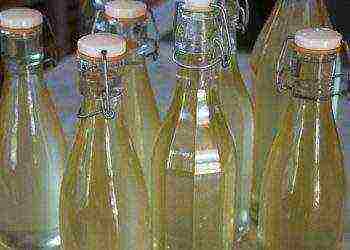
Winemakers and tasters rate gooseberry wines very highly - they are given 9 points on a 10-point scale. Gooseberry wine is especially popular in France.
For the preparation of dry and semi-sweet wines, the following varieties are used:
- "Russian",
- "Kazachok"
- "Weak spiked".
For dessert wines:
- "Chernomor",
- "Anniversary",
- "Plum",
- "Prune" features of cultivation and care.
Heading "Question-answer"
Question number 1. When and how to plant gooseberries?
To plant gooseberries, buy 2 year old bushes or strong 2 year old cuttings. In this case, pay special attention to the roots, which should be no shorter than 20 centimeters. The bushes must have 2-3 strong shoots, the length of which is at least 30 centimeters and several buds.
Tip # 2. Many gardeners believe that autumn planting is much more effective. The best period for this is the end of September and the first decade of October.
Question number 2. Can bushes be planted both in spring and autumn?
Before the onset of cold weather, the root system manages to get stronger, take root, so in the spring the bush begins to grow and develop rapidly. And with the spring planting, the main thing is not to be late. You need to plant the plant while it is dormant. Read also the article: → "September chores, or what is planted in September at the dacha?" Gooseberry buds bloom very early, so planting should be done before early April. However, remember: after planting in spring, the plant takes root much worse.
Rate the quality of the article. We want to be better for you:

